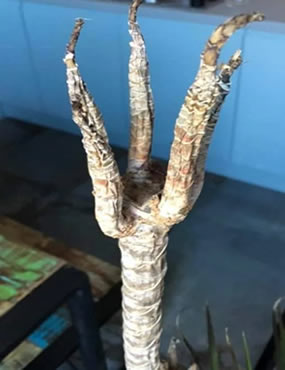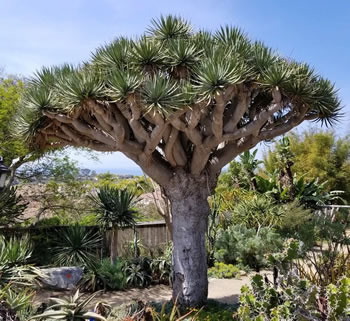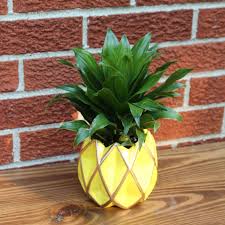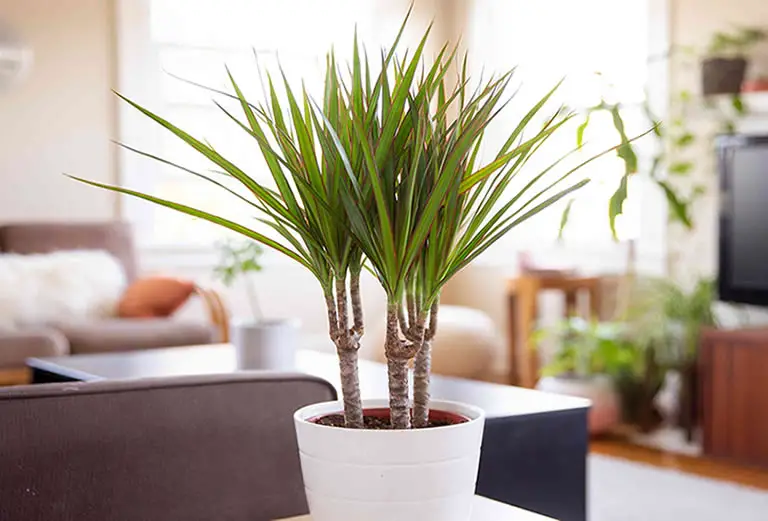Dracaena are very popular houseplants due to their unique looks and easy-care nature. But have you ever wondered what these plants are and where they came from? In this article I tell you everything you need to know about the origins of dracaena, its native habitat. I discuss a few of the different species of dracaena commonly grown as houseplants and even let you know where dracaena got its name.
Table of Contents
- There are many different species of dracaena
- How and why dracaena got its name
- Where dracaena comes from – its native habitat
- Contrary to popular opinion dracaena are not succulents
- Although there is the Dracaena Palm, dracaena are not actually palms!
- Some dracaena plants are considered to be trees while others are considered shrubs
There are many different species of dracaena
Let’s start with answering a question that I hear very often, “what are dracaena plants”.
Dracaena plants are a genus of 120 flowering succulent tress and shrubs that are native to Africa and south Asia, including parts of northern Australia. Dracaena belongs to the broader botanical family Asparagaceae. They are most often cultivated as houseplants in the US.
All dracaena species are classified into one of two groups: shrubs or trees. Both types are cultivated for indoor use in the US.
Dracaena can only be grown as a yard plant, either potted on planted directly in garden soil, in USDA climate zones 10 and 11, though I have heard of it being grown outdoors in zone 9 (where it may need winter protection).
Dracaena, being a tropical succulent, loves warm, humid temperatures. Luckily. the average household experiences a consistent temperature range that falls within the ideal temperature range of for dracaena – 65°F – 75°F. US homes are usually kept at a fairly consistent 70°F year-round thanks to modern heating and cooling systems.
With the aid of a small cheap plant humidifier all species of dracaena can thrive in the average home.
Dracaena plants are toxic to some pets and can cause serious illness or even death in some species of animal.
How and why dracaena got its name
When we look at one of the most popular species of dracaena, that is commonly grown as a houseplant, we can clearly understand where it got its name.
The name dracaena actually has its origins with the ancient Romans.

Just as they did with their gods and culture, the Romans incorporated many ancient Greek words into their language.
The name dracaena is a Romanized version of the Ancient Greek word “δράκαινα” (pronounced drack-in-a), which means “ogress” or, what we would refer to in modern times as, a dragon.
In the image above you can clearly see that a dracaena marginata (the dragon tree) without its foliage very much resembles a dragon claw, nails and all.
Where dracaena comes from – its native habitat
What kind of plant is dracaena?
Dracaena is a name applied to a genus of tropical succulent trees and shrubs that grow natively in Africa, south Asia and northern Australia but that are mostly grown as houseplants in the US. There are 120 different species of dracaena.
Dracaena tress, such as dracaena marginata (known commonly as the dragon tree) can grow quite large when planted outside. As houseplants they tend to reach a height of about 6 – 10 feet.
Dracaena shrubs, like dracaena frans (better known as the dracaena lemon lime plant), will grow to a height of 4 – 6 feet. These types of dracaena tend to be tall and skinny, though there are ways to make a dracaena lemon lime bushier through selective pruning.
Contrary to popular opinion dracaena are not succulents
When it comes to the care of dracaena some houseplant owners get confused about the exact nature of this plant type.
With so many varieties of dracaena available there can be some confusion about the nature and needs of each individual plant type. And, as a dracaena has similar care needs to a succulent but differs in some key areas, many dracaena owners are often left confused as to whether the plant is a succulent or something else.
A dracaena plant is a tropical succulent. Dracaena plants require similar care to other succulents though they do need a special type of soil that can supply the roots with good airflow as well as being able to ensure fast water drainage.
As long as you pot your dracaena in the correct type of soil (see our guide to propagating dracaena) and ensure it gets good localized high humidity the rest of your care routine for the plant can mimic that of the rest of your succulent houseplants.

If you plan to cultivate, or buy, a dracaena houseplant then I recommend you read our article that highlights problems and fixes for dracaena not growing.
The above mentioned article gives detailed information about the exact type of care you should give this plant for maximum healthy growth – and to ensure your plant blooms (which is often a problem for dracaena houseplants).
Be sure to also read our guidelines for dracaena light requirements as giving this succulent the wrong type of light in the wrong quantities will stop the plant from blooming.
Although there is the Dracaena Palm, dracaena are not actually palms!
I am often alarmed when I discover that many dracaena houseplant owners believe they are growing a palm. Having said that, this is an understandable mistake to make as the popular dracaena marginata is regularly marketed and sold as The Dracaena Palm.
Dracaena is not a palm. Dracaena are succulents, palms are not. Some dracaena species are trees, regardless of their size, while others are shrubs. Palm trees are actually not considered trees unless they grow higher than 20 feet. Dracaena marginata (dragon tree) is often called a dracaena palm but it is not a palm.
It is important for you to realise that any dracaena plant that is sold as, or referred to as, a palm is not actually a palm. Why is this important? Because palms and dracaena have very different care needs.
If you mistakenly believe your dracaena plant is a palm and give it the type of care that is perfect for a palm it will likely result in some very serious problems for your dracaena.
For example, palms require watering several times per week, but this type of watering schedule will absolutely lead to a dracaena drooping and, if continued, this watering schedule will eventually lead to the development of dracaena root rot.
See our article how often should I water my dracaena palm and also our lemon lime dracaena watering guide as the information in that article applies to all dracaena plants.
Root rot leads to some very serious issues with any plant. The dracaena will lose all its foliage and start to decay. When a dracaena gets root rot it may not be unsaveable. No matter what solutions you put in place to regrow its leaves the damage to the roots can be so extensive that the plant cannot be revived.
In fact, many care actions required for a palm are so different from the care required for a dracaena that following a palm care routine can result in your dracaena dying very quickly and suddenly.
Some dracaena plants are considered to be trees while others are considered shrubs
With such variety of dracaena available for cultivation in the home and garden many people wonder if this flowering succulent is a tree or a shrub. Some dracaena look so different from each other it is easy to see where the confusion comes from. So is dracaena a shrub or is it a tree?
Dracaena is a broad name given to about 120 species of tropical flowering succulents that consists of both trees and shrubs. For example, the dracaena marginata is a tree (called the dragon tree) while the dracaena frans is a shrub (called the dracaena lemon lime plant).
So, some dracaena houseplants are shrubs while others are considered trees.
Luckily though, the care routine for all dracaena is similar so regardless of whether you own a dracaena tree or a dracaena shrub you can apply the same care to the plant.
A word about the unique pineapple dracaena before you go
One of the questions I am asked about dracaena, as far as its nature and origins go, is related to the less common but still popular dracaena pineapple plant. Many dracaena pineapple plant owners want to know more about the nature of this unique succulent.

The pineapple dracaena is a tropical succulent shrub belonging to the family Asparagaceae. It grows natively in South East Africa. Its botanical name is Dracaena compacta though it is often referred to as the Janet Craig dracaena.
The pineapple dracaena gets its common name from the fact that its foliage resembles the top of a pineapple plant. The two plants are not related though.
You can see in the image above that when a dracaena compacta is potted in a cylindrical container with a diamond patterned exterior, like this pot, the entire thing looks very like a pineapple.

